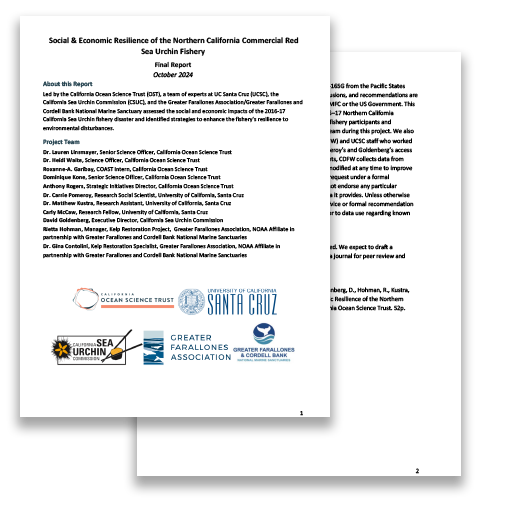
Social & Economic Resilience of the Northern California Commercial Red Sea Urchin Fishery
Full report with social economic research findings, workshop results, and recommendations.
Download the full report


Full report with social economic research findings, workshop results, and recommendations.
Download the full report
Kelp forests along the Northern California coastline have declined by ~90% due to rapidly changing ocean conditions. During this time, key livelihoods and coastal economies suffered, including the North Coast red sea urchin fishery, which was officially declared a fishery disaster in 2019. There is an immediate need to understand how the fishery and fishing communities were impacted by the fishery’s collapse due to kelp loss and what applicable and effective strategies could enhance the fishery and fishing community’s resilience to future environmental change.
With support from the Pacific States Marine Fisheries Commission and in collaboration with UC Santa Cruz, California Sea Urchin Commission, and the Greater Farallones Association, this project assessed the social and economic impacts and responses of fishery participants and communities to collaboratively identify and evaluate potential strategies to improve resilience. The team engaged state and federal resource managers, partners, and fishery participants to ensure project findings and recommendations were practical and implementable by agencies to support the development of a more responsive and resilient framework for kelp loss and associated fishery impacts.
This project began in November 2022 and was completed by October 2024.
Lauren Linsmayer, Ocean Science Trust
Heidi Waite, Ocean Science Trust
Carrie Pomeroy, University of California, Santa Cruz
David Goldenberg, California Sea Urchin Commission
Rietta Hohman, Greater Farallones Association
Gina Contolini, Greater Farallones Association
Dr. Lauren Linsmayer, Senior Science Officer
lauren.linsmayer@oceansciencetrust.org
Dr. Heidi Waite, Science Officer
heidi.waite@oceansciencetrust.org
Support for this work is provided by the Pacific States Marine Fisheries Commission

